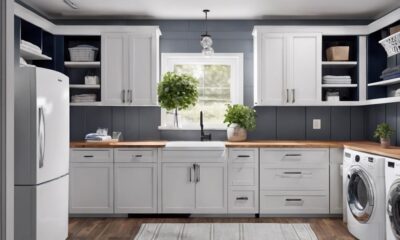Appliances
Pancake Griddle Temp
2025

We all understand how crucial it is to reach the perfect temperature for a pancake griddle for those golden and fluffy pancakes. Are you ready to learn the secret to making the best pancakes of your life? Keep reading to discover!
But how do we ensure that the temperature is just right every time? Well, it's not as straightforward as it may seem.
There are various factors to consider, from the type of griddle you're using to the batter composition and even the cooking environment.
So, let's dive into the world of pancake griddle temperature and uncover the secrets to mastering the art of pancake perfection.
Key Takeaways
- Preheating the griddle to the ideal temperature of around 375°F (190°C) is important for achieving a golden crust and moist interior in pancakes.
- The consistency of the pancake batter determines the thickness and fluffiness of the pancakes. A slightly thicker batter results in fluffier pancakes, while a thinner consistency produces flatter ones.
- Testing the griddle temperature without a thermometer can be done using methods like the water droplet test, butter melting test, and touch test.
- Different pancake types require different temperature settings, such as medium-high heat for fluffy buttermilk pancakes, lower heat for thin crepes, and slightly higher heat for crispy cornmeal pancakes. Adjusting the temperature based on the specific recipe and desired texture is crucial.
The Science of Pancake Cooking
In pancake cooking, the temperature of the griddle plays a crucial role in achieving the perfect texture and browning of the pancakes. When the griddle is preheated to the right temperature, typically around 375°F (190°C), the batter reacts swiftly, forming a golden crust on the outside while maintaining a soft, moist inside. This balance is key to creating fluffy pancakes with an appealing golden finish that aren’t overcooked or underdone. Finding the best griddle temperature for pancakes ensures even cooking and prevents sticking, which can often happen if the griddle is too cold or too hot. Consistently maintaining this optimal temperature will make each pancake a success, whether you’re cooking for a small group or a hungry crowd.
Pancake batter consistency is vital for ensuring the ideal thickness and fluffiness of the pancakes. A slightly thicker batter leads to fluffier pancakes, while a thinner consistency produces flatter ones. To achieve the desired consistency, the liquid-to-dry ingredient ratio must be meticulously calibrated.
Flipping technique is another critical aspect of pancake cooking. The key is to wait for the right moment before flipping. Bubbles forming on the surface and the edges starting to look set are indicators that it's time to flip. A swift, yet gentle motion is needed to ensure the pancake doesn't lose its height and fluffiness. The flipping motion should be decisive to avoid any breakage or misshaping of the pancake. Mastering the art of flipping is essential for achieving evenly cooked, perfectly golden-brown pancakes.
Ideal Temperature Range for Pancakes
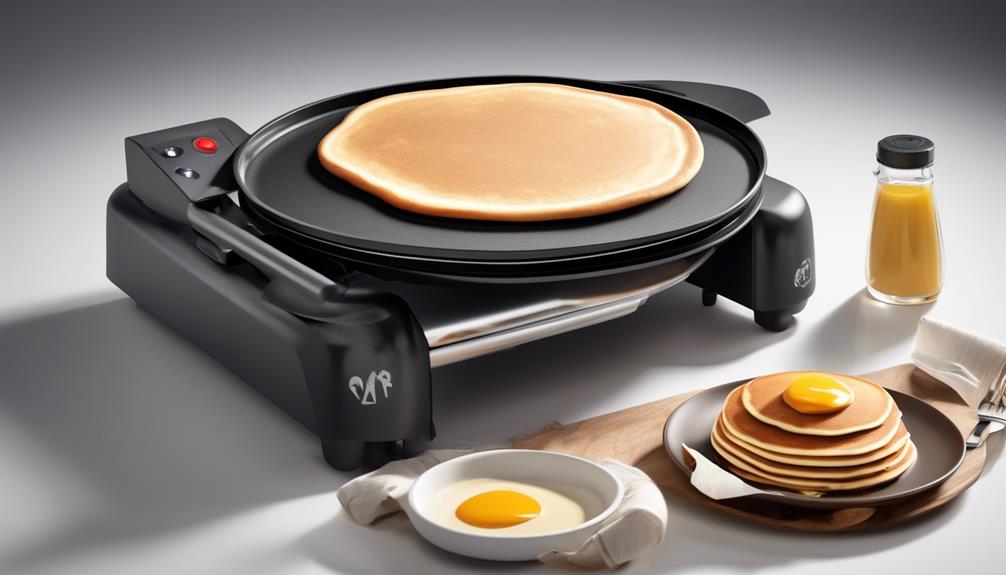
Mastering the ideal temperature range for pancakes is crucial for achieving the perfect texture and browning, which complements the carefully calibrated batter consistency. To attain pancake perfection, it's essential to understand the ideal temperature range for your griddle or pan. Here's what you need to know:
- Initial Heating: Preheat the griddle or pan over medium heat. A temperature of around 350°F (175°C) ensures even cooking without burning the surface of the pancakes.
- Testing Temperature: To test if the griddle is ready, sprinkle a few drops of water onto the surface. If the water sizzles and evaporates quickly, the griddle is at the right temperature for cooking pancakes.
- Adjusting Heat: Maintain a consistent temperature throughout the cooking process. If the pancakes are browning too quickly, reduce the heat slightly. Conversely, if they're taking too long to cook, increase the heat marginally.
- Flipping Techniques: When bubbles form on the surface and the edges appear set, it's time to flip the pancake. Use a flat spatula to ensure a smooth, seamless flip without disturbing the cooking process.
Understanding the ideal temperature range and mastering flipping techniques will elevate your pancake game to new heights.
Importance of Preheating Your Griddle
To achieve optimal cooking results, it's crucial to preheat the griddle thoroughly before starting the pancake-making process. A well-preheated griddle ensures that the pancake batter spreads evenly and cooks consistently, resulting in golden-brown perfection.
The importance of timing can't be overstated when preheating your griddle. It's recommended to preheat the griddle for at least 10-15 minutes before pouring the pancake batter. This allows the entire surface to reach the desired temperature and ensures uniform cooking.
Proper heat control is key to achieving the ideal texture and flavor in your pancakes. Preheating the griddle allows for even distribution of heat, preventing hot spots that can lead to uneven cooking. It also creates a non-stick surface, reducing the need for excessive oil or butter during the cooking process.
Proper heat control during preheating sets the stage for successful pancake making. It enables the batter to cook evenly, prevents sticking, and contributes to the characteristic fluffy texture of well-made pancakes.
Mastering the art of preheating your griddle is essential for consistently delicious pancakes.
Testing Griddle Temperature Without a Thermometer
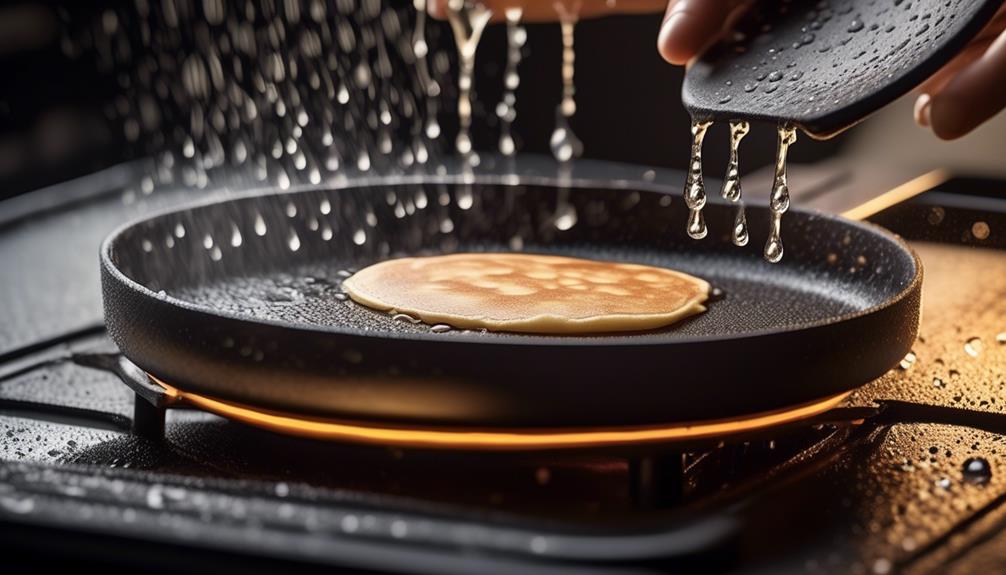
While a thermometer is the most accurate way to measure griddle temperature, you can also test it by sprinkling a few drops of water on the surface and observing their behavior. Here are some testing methods to determine griddle temperature without a thermometer:
- Water Droplet Method: Preheat the griddle and then flick a few drops of water onto the surface. If the water droplets sizzle, dance, and quickly evaporate, the griddle is likely around 375°F, perfect for pancakes. If the water droplets evaporate immediately, the griddle is too hot, and if they just sit there without much sizzle, it's not hot enough.
- Butter Melting Test: Another way to gauge griddle temperature is by placing a small pat of butter on the surface. If the butter melts quickly and evenly, the griddle is at the right temperature for cooking pancakes.
- Visual Cues: Look for visual cues like the color of the griddle surface. A properly preheated griddle usually has a slightly browned surface due to the seasoning or the non-stick coating.
- Touch Test: Carefully touch the griddle surface with a dampened hand. If it sizzles and evaporates immediately, the griddle is ready for cooking.
Using these testing methods can help you achieve the perfect griddle temperature for cooking delicious pancakes.
Adjusting Temperature for Different Pancake Types
When making pancakes, it's crucial to adjust the griddle temperature based on the type of pancake you're preparing. Thin pancakes require a higher temperature for quick cooking, while thick pancakes need a lower temperature to ensure they cook through.
Achieving a fluffy texture and crispy edges also depends on the griddle temperature, so understanding the specific techniques for each type of pancake is essential.
Thin Vs. Thick Pancakes
For thin pancakes, a higher griddle temperature is essential to achieve a quick and even cooking process, while thick pancakes require a lower temperature to ensure thorough cooking without burning the exterior.
When preparing thin pancakes, it's crucial to maintain a consistent batter consistency to ensure the pancakes spread evenly on the griddle. Additionally, mastering the flipping technique is essential to achieve a uniform golden brown color on both sides.
Conversely, when making thick pancakes, a lower griddle temperature prevents the exterior from burning while allowing the inside to cook thoroughly. It's important to pour a thicker batter to achieve the desired thickness and to adjust the cooking time accordingly.
Fluffy Pancake Texture
To achieve the desired fluffy texture in pancakes, adjusting the griddle temperature is crucial, as it directly impacts the cooking process and overall outcome of different pancake types. When aiming for a fluffy texture, it's essential to use a moderate griddle temperature to allow the pancake batter to rise and form air pockets, resulting in a light and airy texture.
Additionally, mastering pancake flipping techniques is key to achieving the perfect flip, ensuring even cooking and maintaining the desired fluffiness.
The choice of cooking oil also plays a significant role in pancake texture. Using oils with a higher smoke point, such as canola or vegetable oil, can contribute to a crispier exterior while maintaining a fluffy interior.
Understanding these factors and making precise adjustments will help in achieving the perfect fluffy pancake texture.
Crispy Edges Technique
Adjusting the griddle temperature is essential for achieving crispy edges on different types of pancakes, allowing for precise control over the texture and browning of the edges. To achieve the perfect crispy texture and edge browning, follow these steps:
- Temperature Adjustment: Set the griddle to a slightly higher temperature than usual, around 375°F to 400°F, to ensure a rapid initial browning without overcooking the center.
- Thinner Batter: Use a thinner batter for your pancakes. This allows the edges to spread out and become crispy while the center cooks evenly.
- Butter Basting: Brush the edges of the pancake with melted butter while cooking to enhance the crispiness and promote even browning.
- Flipping Technique: Flip the pancake only once the edges are golden brown, ensuring that both sides are equally crispy.
Mastering the crispy edges technique requires precision and attention to detail to achieve the perfect balance of texture and flavor.
Tips for Maintaining Consistent Griddle Temp

When it comes to maintaining a consistent griddle temperature, there are a few key points to consider.
We'll discuss heat distribution tips, temperature monitoring tools, and adjusting heat settings to ensure that your griddle stays at the perfect temperature for cooking pancakes.
These tips will help you achieve consistent and delicious results every time you use your griddle.
Heat Distribution Tips
For consistent griddle temperature, it's crucial to evenly distribute heat across the cooking surface. To achieve this, consider the following heat distribution tips:
- Preheat: Ensure the griddle is preheated evenly before cooking to avoid hot spots or uneven cooking.
- Use Proper Utensils: Utilize utensils that conduct heat efficiently to spread it evenly across the griddle surface.
- Manage Heat Zones: Understand the heat distribution zones on your griddle and adjust the cooking position based on the required temperature.
- Rotate and Adjust: Periodically rotate and adjust the position of the food being cooked to ensure even exposure to the griddle surface.
Temperature Monitoring Tools
To ensure consistent griddle temperature, it's essential to monitor and maintain the heat distribution using temperature monitoring tools that complement the heat distribution tips discussed previously.
Temperature control and heat management are crucial for achieving perfect pancakes. One of the most important temperature monitoring tools is a digital thermometer with a probe that can be placed directly on the griddle surface to accurately measure the temperature.
Additionally, infrared thermometers are useful for quickly assessing the temperature of different areas of the griddle. A surface temperature gun can also provide instant readings, allowing for efficient adjustments.
These tools enable precise temperature control, ensuring that the griddle remains at the optimal heat level for cooking pancakes evenly.
Adjusting Heat Settings
We carefully adjust the heat settings on the griddle to maintain a consistent temperature for optimal pancake cooking. Proper heat control is crucial for achieving evenly cooked pancakes.
Here are the key steps for maintaining consistent griddle temperature:
- Preheat the griddle to the desired temperature, typically around 375°F (190°C), and allow it to stabilize before cooking.
- Monitor the temperature using an infrared thermometer or the built-in temperature gauge, making adjustments as needed.
- Adjust the heat settings based on the size and thickness of the pancakes to ensure even cooking.
- Use a consistent cooking time for each side of the pancake, making minor adjustments to the heat settings if necessary to maintain the desired temperature throughout the cooking process.
Common Mistakes and How to Avoid Them
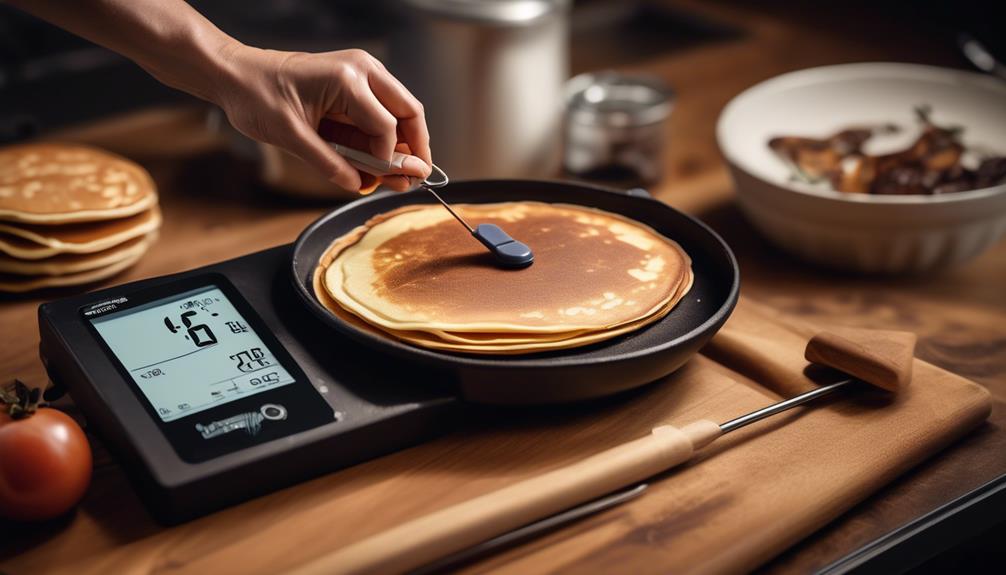
Avoiding common mistakes when using a pancake griddle requires attention to detail and precision in temperature control. One of the most common mistakes is ending up with burnt pancakes. This can happen if the griddle is too hot, causing the pancakes to cook too quickly on the outside while remaining raw on the inside. To avoid this, it's crucial to maintain a consistent and moderate heat level.
Another frequent error is improper flipping technique, which can result in unevenly cooked or misshapen pancakes. To master the art of flipping, use a wide spatula and make sure the pancake is ready to be flipped by checking for bubbles on the surface and a slightly dry edge. When flipping, do so confidently and swiftly, ensuring a smooth transition without disturbing the pancake's shape.
Additionally, avoid repeatedly flipping the pancake, as this can lead to toughening. By paying close attention to temperature control and honing your flipping skills, you can steer clear of these common mistakes and achieve perfectly cooked, golden-brown pancakes every time.
Troubleshooting Uneven Pancake Cooking
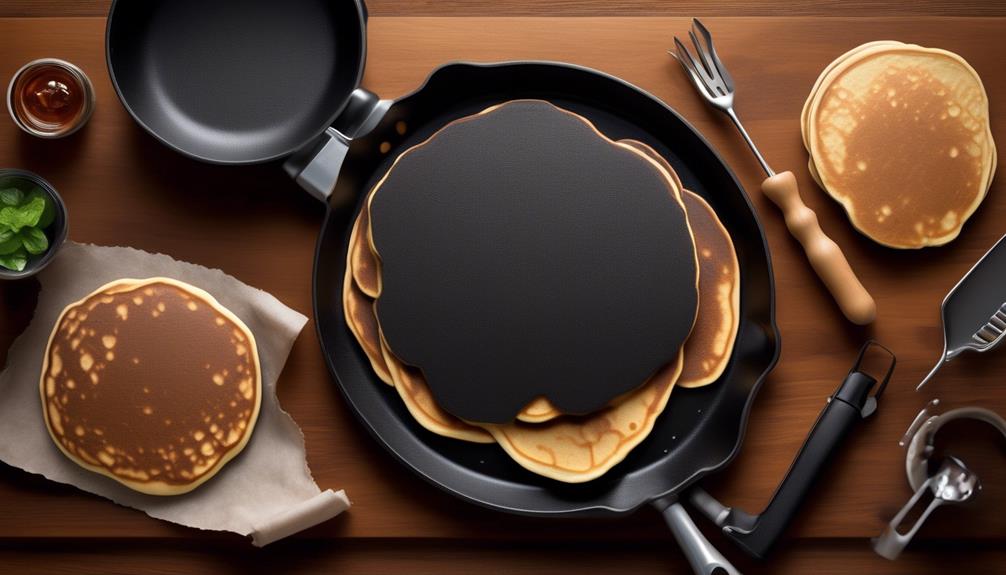
When troubleshooting uneven pancake cooking, ensure that the griddle is evenly preheated to the recommended temperature for optimal and consistent results. Uneven heating can lead to pancakes cooking at different rates, resulting in some being undercooked while others are overcooked. Here are some tips to troubleshoot and improve your pancake cooking:
- Flipping Technique: Master the art of flipping pancakes at the right time to ensure even cooking on both sides. Wait for bubbles to form on the surface, then flip the pancake gently to avoid batter spillage and ensure even browning.
- Batter Consistency: Ensure that the pancake batter is well mixed and has a consistent texture. This will help the pancakes cook evenly without any undercooked spots.
- Using Different Cooking Oils: Experiment with different cooking oils to find the one that best suits your griddle and helps in achieving even browning.
- Flipping Frequency: Avoid flipping the pancakes too often as it can disrupt the cooking process and lead to uneven cooking. Wait for the right time to flip and minimize unnecessary movements.
Frequently Asked Questions
Can I Use a Pancake Griddle Temp for Cooking Other Foods Besides Pancakes?
Yes, a pancake griddle temp is versatile for cooking various foods. It offers precise temperature control for alternative cooking methods.
Griddle temperature is crucial for achieving optimal results when cooking different foods. Its versatility allows us to cook a wide range of dishes such as eggs, bacon, grilled sandwiches, and more.
The temperature control feature ensures that each dish is cooked to perfection, making the griddle a valuable tool in the kitchen.
What Kind of Griddle Should I Use for Making Pancakes?
For making pancakes, the ideal griddle should have a smooth, flat surface to ensure even heat distribution. This is crucial for achieving consistent browning and cooking the pancake batter to the right consistency.
Look for a griddle with a non-stick surface to prevent sticking and aid in flipping the pancakes. Proper heat distribution and a smooth surface are key factors for mastering the art of pancake making.
Can I Use a Regular Frying Pan Instead of a Griddle for Making Pancakes?
Absolutely! Using a regular frying pan for pancakes is totally doable. Just make sure to set the temperature to medium heat to ensure even cooking.
Frying pans can be fantastic alternative cooking surfaces for making pancakes. The even heat distribution and non-stick surface make them perfect for achieving that golden brown perfection.
How Do I Clean and Maintain My Pancake Griddle to Ensure Consistent Temperature?
To maintain temperature consistency, we recommend regularly cleaning your pancake griddle with a non-abrasive cleaner and a soft cloth.
Scrub any residue gently, taking care not to damage the surface.
Use a damp cloth to wipe away the cleaner, and ensure the griddle is completely dry before use.
Regular maintenance will help ensure that your pancake griddle maintains a consistent temperature for perfectly cooked pancakes every time.
What Is the Best Way to Store a Pancake Griddle When Not in Use?
When it comes to storing a pancake griddle, there are a few options to consider. It's important to ensure the griddle is clean and completely dry before storing it.
One option is to store it vertically to save space, while another is to keep it in a protective case or cover.
Regular maintenance tips include checking for any signs of wear and tear and ensuring all parts are in good working condition.
Conclusion
So, as we've learned, maintaining the ideal griddle temperature is crucial for perfect pancakes.
Preheating your griddle, testing the temperature, and adjusting for different pancake types are all key steps in achieving pancake perfection.
But are you ready to take your pancake game to the next level?
With the right temperature and a little practice, you'll be flipping out flawless pancakes every time.
- About the Author
- Latest Posts
Introducing Ron, the home decor aficionado at ByRetreat, whose passion for creating beautiful and inviting spaces is at the heart of his work. With his deep knowledge of home decor and his innate sense of style, Ron brings a wealth of expertise and a keen eye for detail to the ByRetreat team.
Ron’s love for home decor goes beyond aesthetics; he understands that our surroundings play a significant role in our overall well-being and productivity. With this in mind, Ron is dedicated to transforming remote workspaces into havens of comfort, functionality, and beauty.
Garage Door Opener
Clearance Garage Door Opener Installation Guide
Navigate the complexities of installing a garage door opener with ample overhead clearance, uncovering the key steps for a seamless setup.
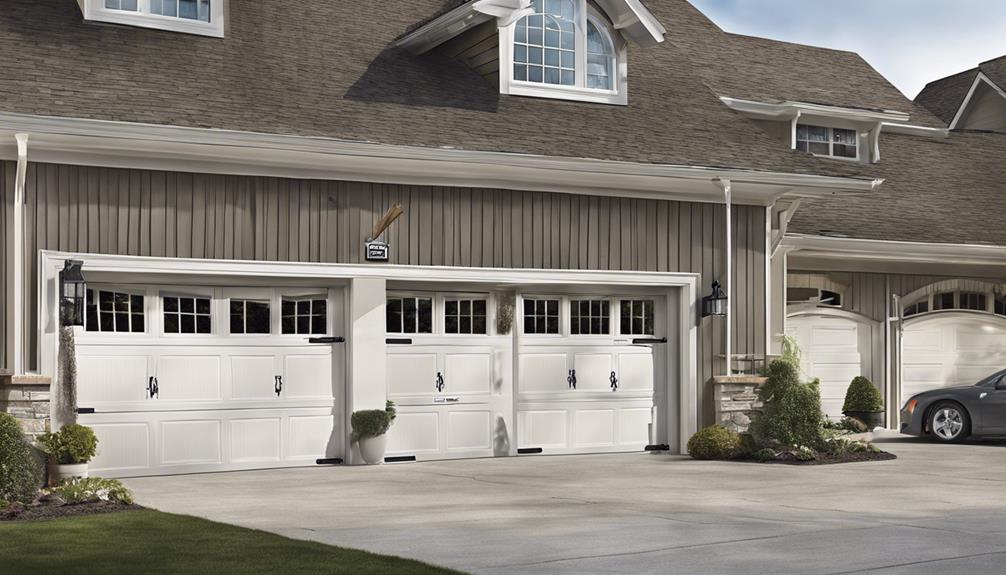
Have you ever thought about the details involved in installing a garage door opener with enough overhead clearance? How difficult is it to make sure the installation is smooth and guarantees the best performance? Well, don’t worry, as we will walk you through the necessary steps for getting your garage door opener set up.
From measuring overhead space to selecting the right opener and testing its functionality, our discussion will equip you with the necessary knowledge to tackle this task effectively. Let's unravel the secrets to a successful garage door opener installation together.
Key Takeaways
- Accurate measurement and ample clearance space are crucial for smooth installation.
- Choose a low-profile opener for limited headroom, featuring modern connectivity and quiet operation.
- Prepare a clutter-free workspace with proper lighting for efficient installation.
- Test functionality thoroughly, adjusting as needed for safe and optimal garage door operation.
Measure Overhead Clearance Space
To ensure proper installation of the garage door opener, it's crucial to accurately measure the overhead clearance space between the top of the garage door and the ceiling. The vertical space is essential for the garage door opener and its components to operate smoothly and without any hindrances.
When measuring the overhead clearance, take into account the drive garage door opener's specifications provided by the manufacturer. These specifications will outline the required vertical space needed for the specific model being installed. Additionally, consider any extra accessories or modifications that may impact the overhead clearance space, ensuring that there's ample room for safe and efficient operation.
Select Low-Profile Garage Door Opener
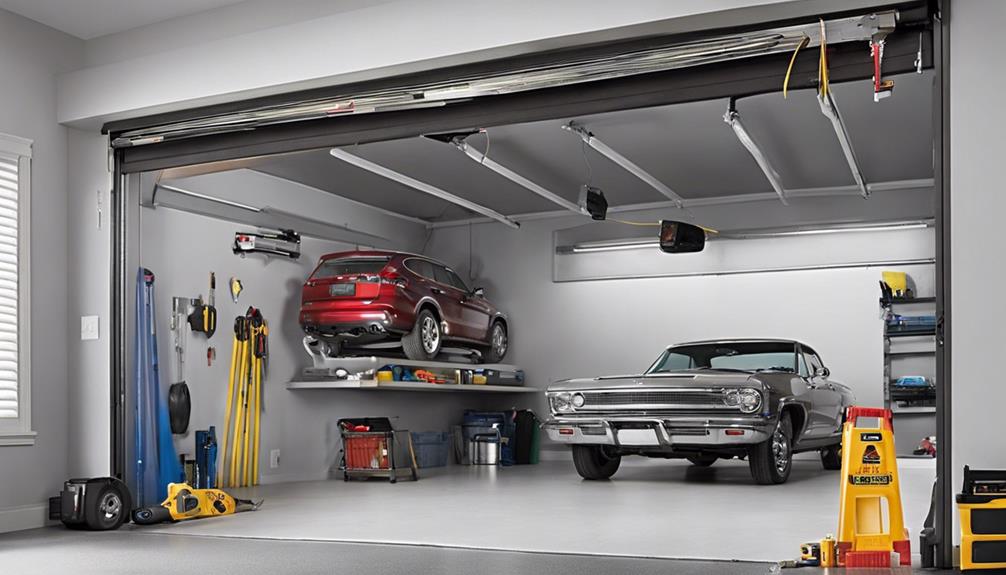
Having ensured the adequate overhead clearance space for the garage door opener installation, the next step is to carefully select a low-profile garage door opener that fits snugly in tight spaces while offering advanced features and compatibility with various door types.
Low-profile garage door openers are specifically designed to accommodate limited headroom situations, making them perfect for garages with space constraints. Their compact and sleek design allows for discreet installation without occupying much room. These openers often come equipped with modern conveniences like smartphone connectivity, battery backup, and quiet belt drive operation for a seamless user experience. Additionally, their compatibility with a range of garage door sizes and types provides installation flexibility.
Energy efficiency is another advantage, as low-profile garage door openers can help reduce electricity consumption, leading to potential long-term cost savings. When choosing a low-profile garage door opener, consider factors such as the size of your garage door and the desired features for optimal performance.
Prepare Workspace for Installation
Clearing the area around the garage door opener is essential to provide ample space for a smooth installation process. Before beginning the installation of the garage door opener, it's crucial to ensure that there are no obstructions or clutter that may hinder the process.
By creating a clean and organized workspace, you can work efficiently and safely. Remove any tools or items that may interfere with the installation of the garage door opener to streamline the process. Keeping the workspace well-lit and free from distractions will allow you to focus on the installation tasks at hand.
Install Opener According to Manual
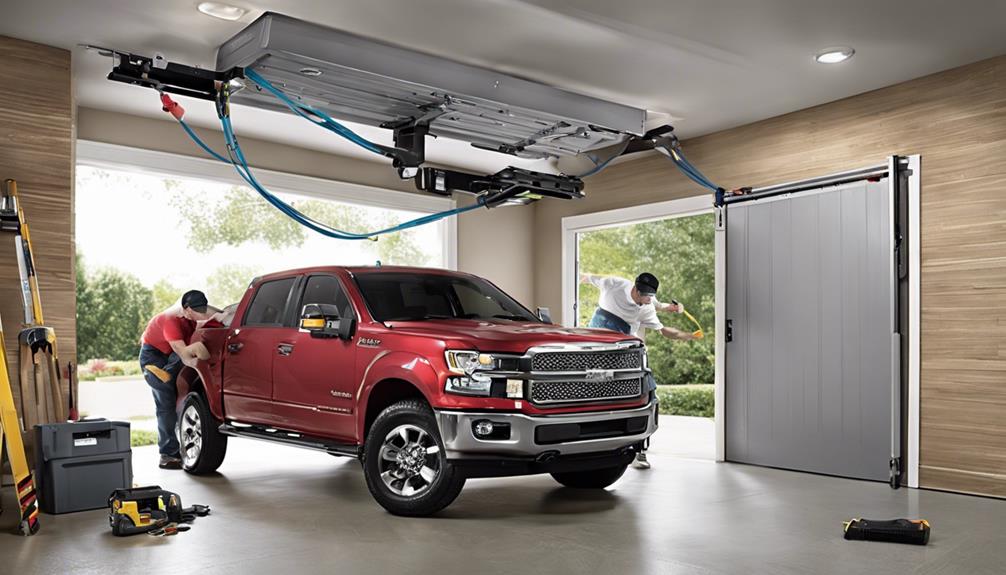
Following the manufacturer's manual meticulously is crucial for the precise installation of the garage door opener. To ensure a successful installation, our team recommends the following steps:
- Positioning Components: Properly position and secure all garage door opener components as instructed in the manual. This ensures the safe and efficient operation of the opener.
- Connecting Wiring: Connect all wiring and mechanisms according to the manual's specifications. Proper connection is vital to prevent malfunctions and ensure smooth functioning of the garage door.
- Adhering to Guidelines: Adhere strictly to the manual's guidelines for installing the opener. These guidelines are designed by professional garage door experts to guarantee a correct and secure installation.
Test Functionality and Adjust if Needed
To ensure the garage door opener functions smoothly and safely, thorough testing and potential adjustments are essential. Begin by testing the garage door's opening and closing functionality multiple times to guarantee a seamless operation.
Listen for any unusual sounds and watch out for jerky movements or obstructions that may impede the door's movement. If any issues arise, consider adjusting the opener's settings to enhance the door's operation and clearance within the garage space.
It's crucial to verify that the door clears the opening without any problems or interference. Additionally, confirm that the safety sensors are operational and don't hinder the door's movement in any way, ensuring a safe and efficient garage door operation.
Frequently Asked Questions
How Much Clearance Do You Need to Install a Garage Door Opener?
We need a minimum of 2 inches of clearance above the garage door for installing most openers. It's crucial to check the manufacturer's specifications for the exact clearance required by your specific opener model.
Taller doors or special opener features may demand more clearance. The needed space can vary depending on the opener type, like chain-drive, belt-drive, or screw-drive.
Adequate clearance ensures smooth opener operation and prevents door movement interference.
What Is the Minimum Clearance Above a Garage Door for an Opener?
We need at least 2 inches of clearance above a garage door for an opener to work effectively. Some models might require up to 3 inches, depending on their design. Too little space can lead to operational issues and potential damage.
It's crucial to measure accurately before installing to avoid problems. Always refer to the manufacturer's guidelines for the specific opener model to ensure the right clearance.
How Much Does Lowes Charge to Install a Garage Door Opener?
We love the convenience of Lowe's garage door opener installation services, starting at $127, with pricing varying based on installation complexity.
Extra charges may apply for services like removing old openers or installing new electrical outlets. Remember, the installation cost doesn't include the price of the garage door opener itself, which must be purchased separately.
Rest assured, Lowe's provides professional installation by licensed and insured contractors for peace of mind.
How Close Do You Have to Be for Garage Door Opener?
We need to be within 25-35 feet for the garage door opener to work.
Sensors should be placed 4-6 inches above the floor to detect obstacles.
Some models offer Wi-Fi connectivity, enabling remote access.
Advanced features like battery backup ensure operation during power outages.
These key factors influence how close we must be for the garage door opener to function effectively.
Conclusion
In conclusion, installing a low-profile garage door opener is like fitting a key into a lock – precise, smooth, and essential for seamless operation.
By following the detailed steps in the clearance garage door opener installation guide, you can ensure your opener functions flawlessly and efficiently.
Remember to test the functionality and make any necessary adjustments for optimal performance.
With proper installation and maintenance, your garage door opener will open up a world of convenience for you.
- About the Author
- Latest Posts
Introducing Ron, the home decor aficionado at ByRetreat, whose passion for creating beautiful and inviting spaces is at the heart of his work. With his deep knowledge of home decor and his innate sense of style, Ron brings a wealth of expertise and a keen eye for detail to the ByRetreat team.
Ron’s love for home decor goes beyond aesthetics; he understands that our surroundings play a significant role in our overall well-being and productivity. With this in mind, Ron is dedicated to transforming remote workspaces into havens of comfort, functionality, and beauty.
Garage Door Opener
What Makes the Glink Garage Door Opener Stand Out?
Outstanding safety features and user-friendly functionalities distinguish the Glink Garage Door Opener – but what else makes it a game-changer?
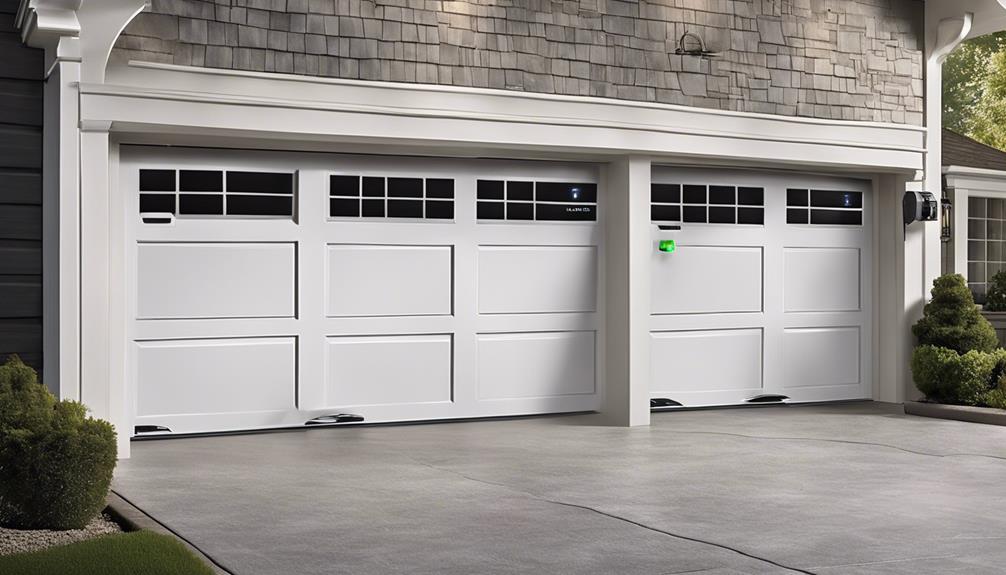
When it comes to garage door openers, the Glink Garage Door Opener really stands out. Its unparalleled level of innovation and attention to detail in features sets it apart in the market.
From cutting-edge safety measures to user-friendly functionalities, the Glink Garage Door Opener has redefined what we expect from this essential home device.
But what exactly makes it stand out from the rest? Let's explore further.
Key Takeaways
- Built-in camera for live monitoring adds security and convenience.
- Belt-driven openers ensure quiet performance for a peaceful environment.
- Advanced Wi-Fi connectivity allows for remote access and smart home integration.
- High-grade steel construction and advanced motor technology ensure durability and reliability.
Innovative Features of Glink Garage Door Opener
The Glink Garage Door Opener revolutionizes home security with its cutting-edge built-in camera for live monitoring capabilities, setting a new standard in garage door technology. When it comes to garage door maintenance, one crucial aspect is the proper lubrication of moving parts to ensure smooth operation. The Glink opener excels in this area by incorporating a sophisticated spring system that enhances the overall functionality and longevity of the garage door.
Furthermore, the Glink Garage Door Opener is designed with belt-driven openers that not only reduce the noise during operation but also provide a more reliable performance compared to chain-driven systems. This innovative feature enhances the user experience by offering a quieter and more efficient operation that's essential for modern homeowners seeking convenience and peace of mind.
User-Friendly Design Highlights

Featuring intuitive controls and seamless integration with smart home systems, the user-friendly design of the Glink Garage Door Opener offers unparalleled convenience and security for homeowners. Here are some highlights that make it stand out:
- Easy-to-Use Controls: The Glink Garage Door Opener provides straightforward controls, allowing users to operate their garage doors with ease.
- Smart Home Integration: With compatibility for smart home systems, users can conveniently monitor and control their garage doors remotely using their smartphones or voice commands.
- Safety Sensors: Equipped with advanced safety sensors, the opener detects obstacles in the door's path, ensuring the safety of both people and property.
- Quiet Operation: The Glink Garage Door Opener operates quietly, making it ideal for garages attached to living spaces where noise reduction is essential.
The straightforward installation and setup process further enhance the user-friendly experience, making the Glink Garage Door Opener a hassle-free addition to any home.
Reliable Performance Factors
Among the standout features of the Glink Garage Door Opener, its reliable performance factors set a high standard in the realm of garage door operation and security.
The Glink Garage Door Opener utilizes DC motors, which provide efficient and smooth operation, especially when paired with a belt-driven garage door mechanism. This combination not only ensures a reliable performance but also contributes to reducing the noise level during door operation, making it ideal for homes where noise pollution is a concern.
Additionally, the inclusion of a safety sensor system enhances the overall reliability of the opener by detecting any obstructions and prompting the door to stop and reverse its motion, prioritizing user safety.
Moreover, the smart technology integration allows for convenient control and monitoring of the garage door opener remotely, adding an extra layer of security and accessibility.
The Glink Garage Door Opener's reliable performance factors make it a top choice for those seeking a dependable and efficient garage door solution.
Glink Garage Door Opener Durability
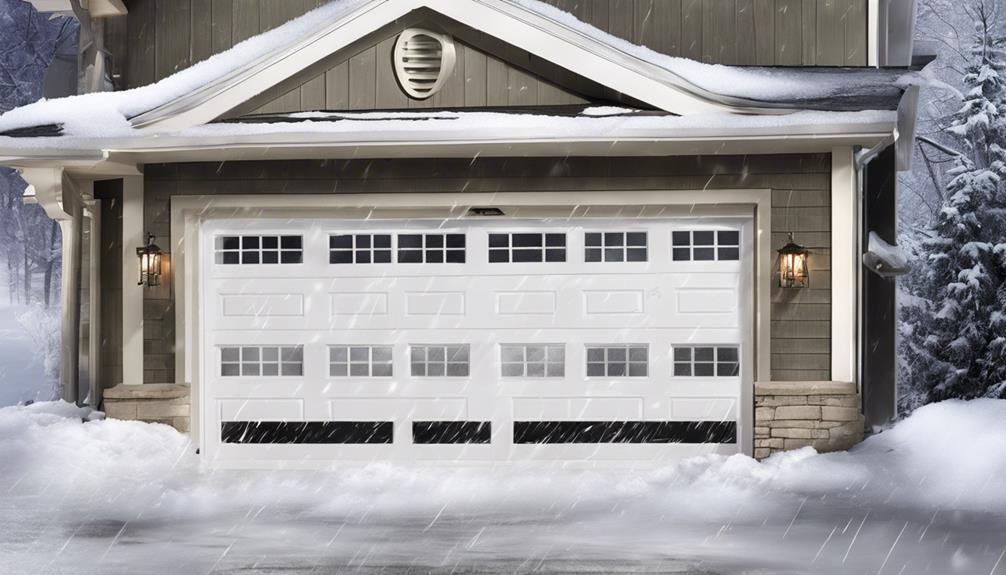
How does the durability of the Glink Garage Door Opener compare to other models on the market? When it comes to lasting strength and reliability, the Glink Garage Door Opener stands out from the competition. Here's why:
- Durable Materials: Crafted from high-grade steel and reinforced components, the Glink Garage Door Opener is built to withstand the test of time, ensuring longevity and robust performance.
- Advanced Motor Technology: Equipped with cutting-edge motor technology, this opener delivers powerful and efficient operation, enhancing its durability and overall functionality.
- Residential Garage Door Operation: Designed specifically for residential use, the Glink Garage Door Opener is tailored to meet the demands of daily home access, supporting consistent and reliable performance.
- Minimal Maintenance Requirements: With a focus on user convenience, this opener requires minimal maintenance, allowing homeowners to enjoy hassle-free operation without frequent upkeep tasks.
Standout Technology in Glink Opener
The advanced Wi-Fi connectivity of the Glink Garage Door Opener sets it apart in the realm of smart home technology, offering users convenient remote access to their garage door from any location. This feature enables seamless control through the Glink mobile app, empowering users to monitor and manage their garage door with just a few taps on their smartphone. Moreover, the Glink Opener's compatibility with voice assistants such as Amazon Alexa and Google Assistant adds a layer of hands-free convenience, allowing users to operate their garage door effortlessly using voice commands.
The integration of smart technology in the Glink Garage Door Opener further enhances its standout features. Through real-time alerts and notifications, users are kept informed about the status of their garage door, enhancing both security and peace of mind. Additionally, the ability to schedule automatic opening and closing times streamlines daily routines, making the overall user experience more efficient and tailored to individual preferences. The Glink Opener truly represents a modern approach to garage door operation, combining innovation with practicality for a liberating user experience.
Frequently Asked Questions
How Can I Boost My Garage Door Opener Signal?
To boost our garage door opener signal, we can take several steps.
Reposition the antenna for better reception and remove any obstructions blocking the signal.
Upgrading to a dual-frequency remote control can enhance signal strength.
Installing a repeater or range extender can amplify the signal.
Checking for interference from nearby electronics is crucial to ensure a smooth signal transmission.
These steps can help improve the overall performance of our garage door opener system.
Which Is Better a Chain or Belt Garage Door Opener?
When comparing a chain and belt garage door opener, it's crucial to consider factors like noise level, cost, reliability, and durability based on personal needs.
Chain openers are cost-effective and robust, ideal for heavy doors or high-traffic areas.
On the other hand, belt openers offer quieter operation and require less maintenance.
Ultimately, the choice depends on individual preferences, budget constraints, and specific garage door requirements.
What Is the Best Residential Garage Door Opener?
When it comes to choosing the best residential garage door opener, safety features like automatic reversing and rolling code technology are crucial. Battery backups ensure operation during power outages, while security lights provide added safety. Consider different types such as chain-driven, belt-driven, screw-driven, direct drive, and jackshaft models.
LiftMaster series like 8365, Elite Series 8550 DC, and 8500 offer excellent features for residential use, catering to various needs.
How Much Horsepower Do I Need for a 2 Car Garage Door?
We've got the know-how on garage door openers! A 1/2 horsepower opener is typically enough for a standard 2 car garage door.
If you've got a heavier or insulated door, consider bumping up to a 3/4 or 1 horsepower for optimal performance. The right horsepower ensures smooth operation and longevity for your opener.
Consult a pro to determine the best fit for your specific garage door setup.
Conclusion
In conclusion, the Glink Garage Door Opener truly shines with its innovative features, user-friendly design, reliable performance, and durability.
It stands out in the market for its advanced safety technology and standout features like automatic reversing and rolling code encryption.
With the Glink Garage Door Opener, you can rest assured that your garage door will operate smoothly and securely.
It's like having a guardian angel watching over your home's entrance.
- About the Author
- Latest Posts
Introducing Ron, the home decor aficionado at ByRetreat, whose passion for creating beautiful and inviting spaces is at the heart of his work. With his deep knowledge of home decor and his innate sense of style, Ron brings a wealth of expertise and a keen eye for detail to the ByRetreat team.
Ron’s love for home decor goes beyond aesthetics; he understands that our surroundings play a significant role in our overall well-being and productivity. With this in mind, Ron is dedicated to transforming remote workspaces into havens of comfort, functionality, and beauty.
Garage Door Opener
Silencing Your Garage Door Opener Humming: A Step-by-Step Guide
Discover how to silence your garage door opener humming with expert tips and tricks, transforming your space into a noise-free haven.

We’ve got you covered with practical steps to tackle the noise when it comes to silencing your garage door opener humming.
From pinpointing the source of the hum to exploring maintenance techniques, our guide offers a comprehensive approach to quieting your garage door opener.
By implementing these methods, you can create a peaceful environment without the constant background hum.
So, are you ready to transform your garage into a serene space?
Key Takeaways
- Inspect transformer for issues in Legacy 850/Standard Drive 650 models.
- Tighten all hardware components to minimize vibrations and humming.
- Regularly lubricate moving parts to reduce friction and noise.
- Adjust opener settings for optimized force and smooth operation.
Identifying the Source of Humming
To pinpoint the source of the humming noise in your garage door opener, start by examining the transformer located in the motor head for any signs of malfunction. The transformer is crucial for converting incoming power to the appropriate voltage needed to operate the DC motors in garage door openers like the Legacy 850 or Standard Drive 650.
If you own one of these models and notice a persistent humming sound, the transformer may be the culprit. For Legacy 850 or Standard Drive 650 units with a date code before 15198, replacing the transformer (part #39342RS) is often the solution. These replacement transformers for Overhead Door model openers can be easily sourced from www.OverheadDoorPartsOnline.com.
If you encounter any challenges during the replacement process or need further assistance, don't hesitate to reach out to your local Overhead Door distributor at 1-800-929-3667 for expert technical support. Identifying and addressing issues with the transformer can help silence the humming and ensure smooth operation of your garage door opener.
Inspecting and Tightening Hardware

Inspecting and tightening the hardware components of your garage door opener is crucial to identifying and addressing potential sources of humming noise. Begin by checking for loose nuts, bolts, and screws on the opener. Using a wrench, tighten all hardware components securely to reduce vibrations and minimize humming. Ensure that the mounting brackets, chains, and railings are properly fastened to prevent unnecessary movement and humming. It's also essential to inspect the motor head and drive system for any loose parts that could be causing the humming sound.
Regularly tightening and securing the hardware of your garage door opener is key to maintaining a quiet and efficient operation. Loose components can lead to increased vibrations and noise levels. By keeping all nuts, bolts, screws, mounting brackets, chains, railings, and motor head properly tightened, you can significantly reduce the humming noise coming from your garage door opener. This simple maintenance task can make a big difference in the overall performance of your garage door system.
Lubricating Moving Parts
When lubricating the moving parts of your garage door opener to reduce humming noise, ensure thorough coverage using a garage door lubricant or silicone-based option. Regular maintenance of your garage door opener includes proper lubrication of its moving parts such as the chain, belt, or screw drive. This lubrication helps reduce noise by preventing excess friction between the components. To assist you in understanding which lubricant to use and where to apply it, refer to the table below:
| Moving Parts | Recommended Lubricant |
|---|---|
| Chain Drive | Garage Door Lubricant |
| Belt Drive | Silicone-Based Lubricant |
| Screw Drive | Garage Door Lubricant |
Adjusting Garage Door Opener Settings

Adjust garage door opener settings to minimize humming noise by accessing the control panel and fine-tuning force and travel limits. Here's how to do it:
- Access the Control Panel:
- Locate the control panel on your garage door opener, usually found near the motor unit.
- Open the panel cover to reveal the adjustment settings.
- Adjust Force Settings:
- Use a flathead screwdriver to adjust the force settings on the opener.
- Increase or decrease the force to find the optimal setting that reduces resistance and noise.
- Fine-Tune Travel Limits:
- Locate the travel limit adjustment screws on the control panel.
- Gradually adjust the travel limits for both opening and closing directions.
- Test the door after each adjustment to ensure it opens and closes smoothly without excessive noise.
Seeking Professional Help
For addressing unusual humming sounds in your garage door opener, it is advisable to seek professional assistance from a certified technician. When dealing with a persistent humming noise coming from your garage door opener, it is crucial to involve experts who can accurately diagnose and resolve the issue. Certified technicians have the knowledge and experience to identify the source of the unusual sound and provide appropriate solutions to eliminate it effectively.
To guide you in understanding the benefits of seeking professional help, refer to the table below:
| Benefits of Seeking Professional Help | |
|---|---|
| 1. Expert Diagnosis | Certified technicians can pinpoint the exact cause of the humming noise. |
| 2. Precise Resolution | Professionals offer targeted solutions to resolve the issue efficiently. |
| 3. Technical Support | Get access to specialized assistance for your garage door opener complications. |
| 4. Prevent Further Damage | Avoid potential harm by allowing trained professionals to handle the motor head. |
When faced with a garage door opener humming problem, don't hesitate to reach out to a certified technician for technical support and expert troubleshooting.
Frequently Asked Questions
How Do I Silence My Garage Door Opener?
To silence your garage door opener, locate the source of the noise, which may be the motor head. Check the transformer for any issues causing the humming sound.
If you have a Legacy 850 or similar model, consider replacing the transformer part. For specific parts and guidance, visit OverheadDoorPartsOnline.com or reach out to a local distributor for assistance.
This process will help eliminate the unwanted noise from your garage door opener.
Why Is My Garage Door Opener Making a Humming Noise?
We discovered why our garage door opener is humming. It seems the culprit might be a faulty transformer in the motor head.
This issue is common in garage door openers with DC motors like the Overhead Door Phantom (777CD) and Legacy 850 (2029). If you have a Legacy 850 with a date code before 15198, replacing the transformer (part #39342RS) could be the fix.
Look for replacement transformers at www.OverheadDoorPartsOnline.com or call 1-800-929-3667 for help.
How Do I Make My Garage Door Not Loud?
To make our garage door not loud, we can start by lubricating the moving parts to reduce noise from friction. Check for loose chains or belts that might be causing the loudness.
Upgrading to a belt-driven opener can also help for quieter operation. Inspect the motor head for loose components.
If the noise persists, it's best to seek help from a professional technician for an effective solution.
How Do I Stop My Electric Buzzing?
If you're looking to halt that electric buzzing, we've got you covered.
First, pinpoint the source of the sound, often linked to a malfunctioning transformer in the motor head. Models like the Overhead Door Phantom (777CD) and Legacy 850 (2029) with DC motors commonly face this issue.
For specific models like the Legacy 850 or Standard Drive 650 predating 15198, think about replacing the transformer (part #39342RS).
Need replacement transformers? Check out www.OverheadDoorPartsOnline.com.
Conclusion
In conclusion, by following the steps outlined in this guide, we can effectively address the issue of garage door opener humming and ensure a more peaceful and efficient operation.
Remember, with regular maintenance and proper care, we can achieve a quieter and smoother functioning garage door opener.
Don't hesitate to seek professional assistance if needed, as it can further enhance the performance of your garage door system.
- About the Author
- Latest Posts
Introducing Ron, the home decor aficionado at ByRetreat, whose passion for creating beautiful and inviting spaces is at the heart of his work. With his deep knowledge of home decor and his innate sense of style, Ron brings a wealth of expertise and a keen eye for detail to the ByRetreat team.
Ron’s love for home decor goes beyond aesthetics; he understands that our surroundings play a significant role in our overall well-being and productivity. With this in mind, Ron is dedicated to transforming remote workspaces into havens of comfort, functionality, and beauty.
-

 Decor1 week ago
Decor1 week agoMaximalist Decor Explained: Embrace More Style
-

 Vetted2 weeks ago
Vetted2 weeks ago15 Best Foot Massagers for Neuropathy to Soothe Your Feet and Relieve Discomfort
-

 Vetted3 weeks ago
Vetted3 weeks ago15 Best Sports Laundry Detergents for Keeping Your Activewear Fresh and Clean
-

 Vetted3 weeks ago
Vetted3 weeks ago15 Best Tall Toilets for Seniors That Combine Comfort and Safety
-

 Vetted4 weeks ago
Vetted4 weeks ago15 Best Dish Scrubbers to Keep Your Kitchen Sparkling Clean
-

 Vetted2 days ago
Vetted2 days ago15 Best Cleaners for Fiberglass Showers to Keep Your Bathroom Sparkling Clean
-

 Decor4 weeks ago
Decor4 weeks agoWhat Is Eclectic Home Decor
-

 Vetted1 week ago
Vetted1 week ago15 Best Organic Pest Control Solutions for a Naturally Pest-Free Home












